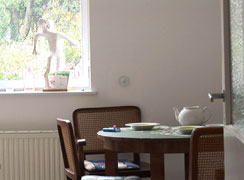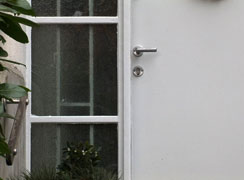Home / / Photo / Sculptures / Curatorial Projects / Bio / Contact
![]()

![]()

![]()

![]()
> stills and quotes
![]() > installation views
> installation views
![]() > photo series
> photo series
![]()
forms in relation to life / the Vienna Werkbundsiedlung
HD Video, 60 min, 2014
In his text Harmony in the art of building published in the exhibition catalog Die Internationale Werkbundsiedlung Wien 1932 Oskar Strnad speaks of “the harmony between nature and geometric forms which have become meaning.” Referencing this and other ideals of involved architects, the film looks at how the ideas of the model houses are “lived“ today, 80 years after their completion.
32 Austrian and international architects, among them Josef Hoffmann, Adolf Loos, Oswald Haerdtl, André Lurçat, Richard Neutra, Ernst Plischke, Gerrit Rietveld, Oskar Strnad and Margarethe Schütte-Lihotzky were invited by Josef Frank to build one and two family homes with gardens for this model housing estate in Vienna‘s 13th district. The aim was to create comfortable and cost-efficient housing within minimal space, as an alternative to the superblock structures the city built at the time. After the exhibition, only a few of the houses were sold. The majority of the houses was eventually rented through the “Wiener Wohnen” (affordable housing) program by the city of Vienna.
This basic idea: to maximize the utilization of minimal resources ... to create space for real life. (Walter Sobotka)
I tried to capture the search for this “real life“ in images, visiting residents in their houses and gardens over the period of one year. The inhabitants recount personal stories and anecdotes, and reflect on the social fabric within the estate.
The film looks at what ideas were fulfilled and which ones failed, how the residents have adapted the houses to their own needs, how they deal with the minimal living space, the restrictions imposed by landmark regulations or the frequent tourist visits. A loose collection of the various characters, stories and lifes taking place in the estate.
People will live there and have visitors, small friendships and big enmities will please and hurt. The exhibition will turn into a residential estate, once and until the connection between house and happiness, of home and experience happens. Once not only the kids brought in by the new owners but the newborns will cry there, once the dead are taken away. Once people will live there.
(Johannes Ilg: Die Werkbund-Siedlung, in: Wiener Allgemeine Zeitung, July 29, 1932, page 6).
with: Elisabeth Gaisser, Angelika Grasmuck, Raimund Heinz, Margot & Anatol Hruby, Ivana, Fabian & Vanessa Jäger, Susanne Kompast, Elfriede Mislik, Helga Mislik, Brigitte Perner, Walter Raschbach
kids: Pablo Brudermann, Maja Dertschei, Kuba Holzfeind, Lino, Luca & Vita Horak, Ferun & Miex Mayer, Rosali Michalka, Miles Mungin
concept/camera/editing: Heidrun Holzfeind; additional camera (costume parade): Ruth Kaaserer
![]()
![]()
![]()
-